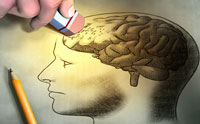“Here is another excellent example of the incredible complexity that is found all throughout both the plant and animal kingdoms. Yet astonishingly evolutionist keep insisting that all this occurred by random chance and expect people to be gullible enough to believe that. Sadly, many do.” Admin Proteins inside plant cells transmit jasmonate’s Paul Revere-like message to their nuclei where intermediate messengers activate and coordinate different defense-related genes. More… …read more Read more here: icr.org
“Evidence is building that Earth life originated on Mars ….” But this claim dismisses a long list of invalidating factors. More… …read more Read more here: icr.org
Like modern rodents, “primitive” multituberculates were already fully equipped to go anywhere and eat anything. …read more Read more here: AIG Daily
When evolution predictions go wrong … …read more Read more here: creation.com
Bats fly and dolphins swim, but both mammals are equipped with a sort of biological sonar. How did they both get this ability? …read more Read more here: AIG Daily
Two new DNA sequencing studies claim that all males trace back to a Y chromosome “Adam” who lived 120,000-200,000 years ago. More… …read more Read more here: icr.org
Countless people have been convinced by the wonders of the developing embryo—falsely portrayed—that evolution must be true. Why is this falsified idea still accepted by many teachers and scientists? …read more Read more here: AIG Daily
Amazingly, scientists documented the activity of 2,082 distinct pseudogenes in the human genome whose aberrant levels of activity were directly associated with cancer-specific pathologies. More… …read more Read more here: icr.org
If you thought borax was a good laundry additive, wait until you see what it can purportedly do for the origin of life! …read more Read more here: AIG Daily
Point to a Creator who provides. …read more Read more here: creation.com
Even if the coded information required to build a new generation of cells may not be stored in DNA, then it is stored somewhere in the cell—information placed there by God, not by physics. Structuralism falls short. More… …read more Read more here: icr.org
Plant hopper nymphs have interlocking toothed gears to synchronize their jumping legs. …read more Read more here: creation.com
“It’s just amazing the complexity they are finding as research goes on. With each level of complexity found the Darwinian theory becomes all the more untenable. However diehard Darwinists will fight to the bitter end (and for them it will be a bitter end) to keep this dead horse propped up.” Admin Researchers recently found that variation in flowering and root growth in plants was associated with epigenetics, which radically challenges long-cherished evolutionary ideas about genetics. Some have even called it “evolution heresy.” More… …read more Read more here: icr.org
To explain echolocation without a designer, evolutionists now claim ‘200 genes had independently changed in the same way.’ This extensive homoplasy / ‘convergence’ undermines homology claims in building evolutionary trees. …read more Read more here: creation.com
Early Cretaceous flea found to “fill the transitional gap.” …read more Read more here: AIG Daily
Can a birds’ eye view explain the evolution of animal ornamentation and courtship behavior? …read more Read more here: AIG Daily
“Another great example of Gods handiwork but what do evolutionists attribute this complex feature to: “Morpho butterflies are a brilliant spectacle of nature’s capacity for photonic engineering.” Once again they credit Nature with some mysterious intelligence that surpasses even mans, but what they really mean is that random chance and mindless mutations were responsible but realizing how absurd that sounds they have to cloak it in some flowery language to hopefully fool the gullible.” Admin Where do butterflies get their brilliant colors? It seems that whoever designed the structures that cause the colors had expert knowledge of optics and nanotechnology, [More]
“Excellent article. How anyone could think that such a super sophisticated visual system could be the product of random chance is beyond me, since its complexity fairly shouts that it had to have been designed. If you would like to see more marvels of design watch the video God Of Wonders Here” Admin The fine nanorod structure of the mantis shrimp eyes allow it to rotate the polarization across the spectrum. This could help DVD players to process much more information. …read more Read more here: creation.com
Surely 160 million years of evolutionary history would have produced more “evolutionary also-rans” before developing the “strong, adaptable animals” that fossils actually reveal. Where are all of evolution’s experiments? More… …read more Read more here: icr.org
When “he shall return to the days of his youth,” will the redeemed person enjoy a perfect memory more like Adam’s? More… …read more Read more here: icr.org
Freeze-tolerant frogs exhibit a complex array of adaptations perfectly tailored for harsh Alaskan winters. …read more Read more here: AIG Daily
The HBBP1 gene appears to be a highly functional and cleverly integrated feature of the human genome that is intolerant of mutation. …read more Read more here: AIG Daily
Gluttonous bacteria on the fast track compete with biofilm-makers boldly going where bacteria haven’t gone before. Rapidly “evolving” bacteria are in the news. A mutation toggling the bacteria Pseudomonas aeruginosa between two distinct forms is generating excitement among evolutionary biologists. Joao Xavier of Memorial Sloan-Kettering Cancer Center and colleagues report in Cell Reports that they have repeatedly observed Pseudomonas evolve into “hyperswarmers.” …read more Read more here: AIG Daily
The problem for the evolutionary model of animal origins is the fact that these “orphan” DNA sequences appear suddenly and fully functional without any trace of evolutionary ancestry. More… …read more Read more here: icr.org
Scientists studying the molecular structure of the ubiquitous enzyme thioredoxin claim that by “traveling back in time” they have unlocked a vital clue to our ancient world. …read more Read more here: AIG Daily
We will discuss how instructors are using the Hardy-Weinberg Principle as evidence for molecules-to-man Darwinian Evolution, why this method of application is incorrect. …read more Read more here: AIG Daily
Later during pregnancy, progesterone levels drop, and this enables both the mother's immune system and her tiny baby's required supply of cholesterol to ramp up at the perfect pace. More… …read more Read more here: icr.org














































